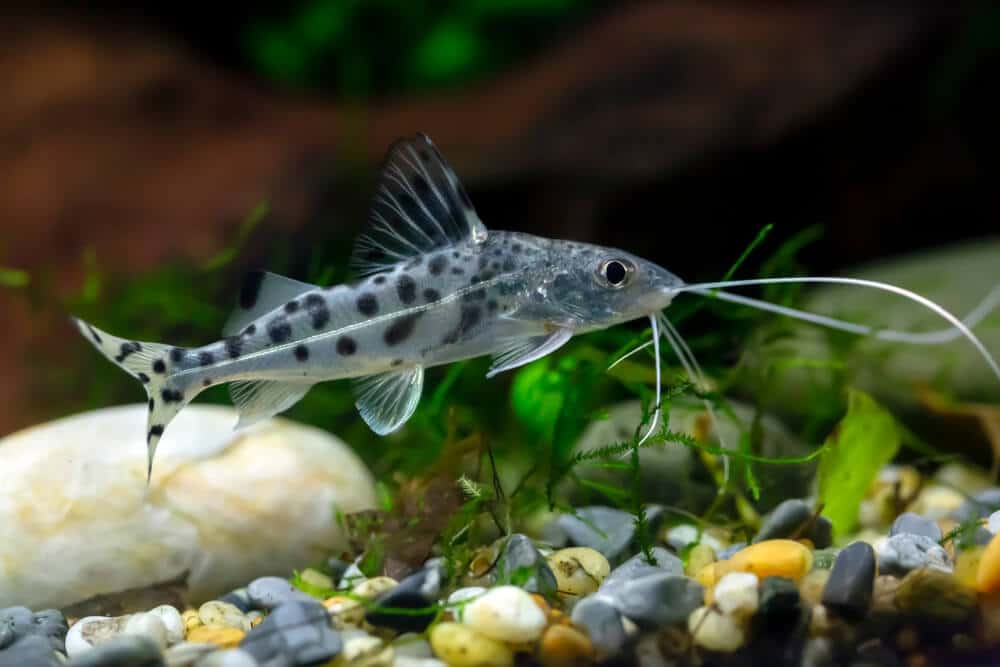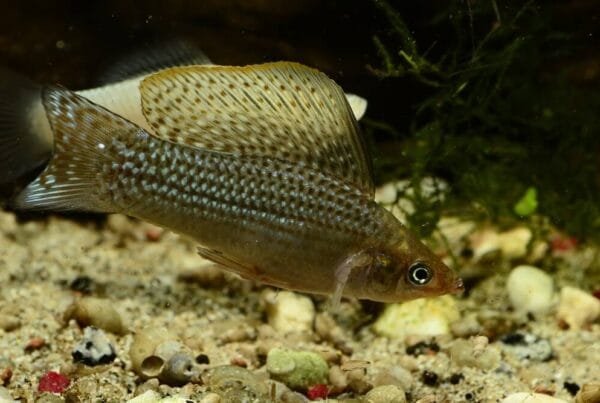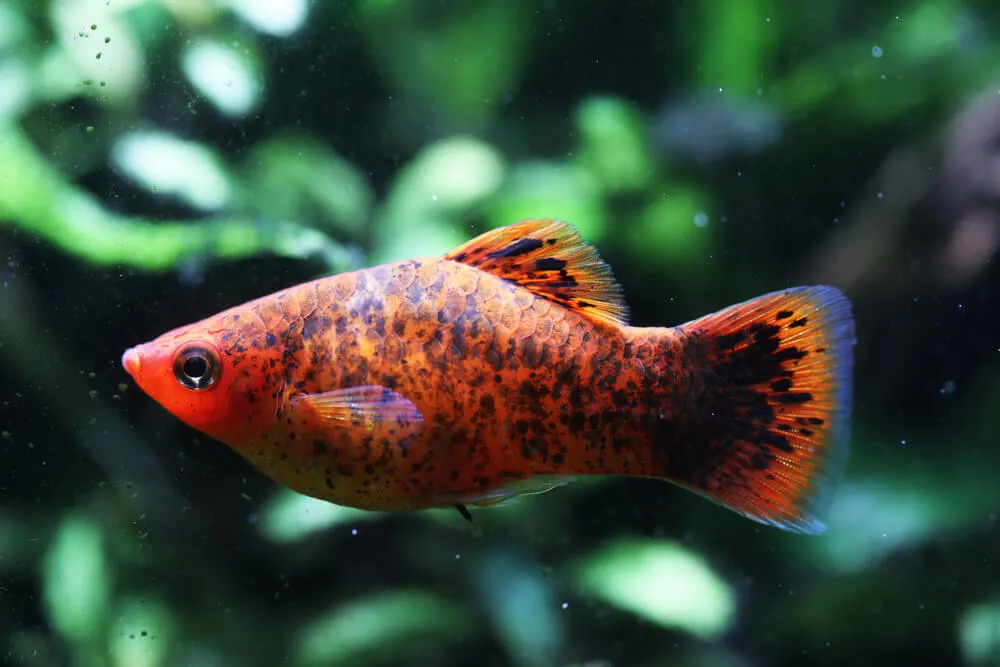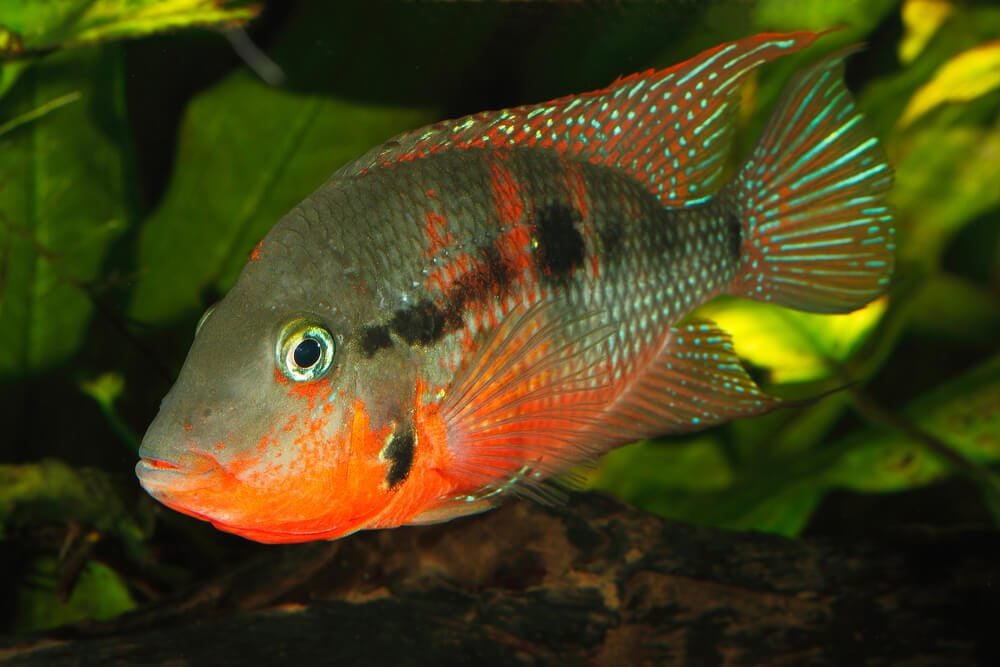The Pictus Catfishes are fan-favorite fishes for a variety of reasons. They’re adorable, easy to take care of, peaceful, and have uniquely long whiskers or barbels. Those things make them stand out more when they swim across the fish tank.
Some of the best tank mates for Pictus catfish include Blue Gourami, Glass Catfish, and Silver Dollar, to name a few. If you want to know about other compatible tank mates for Pictus Catfish, then continue reading this article.
Pictus Catfish (Pimelodus Pictus) Overview
Size: 5 Inches
Minimum Tank Size: 55 Gallons
Temperament: Peaceful
Diet: Omnivorous
Care Level: Easy
Appearance:
The best feature of the Pictus Catfish has got to be the whiskers or barbels. These things can grow at the same length as their bodies, which measure about 5 inches. As the Pictus Catfish swim across the aquarium, the barbels also float gracefully. Aside from aesthetics, those things are functional, too, especially for searching for food.
Pictus Catfishes usually have gray or silver-colored abdomens. There are also black or dark brown spots appearing on the bodies. The more spotted they are, the more stunning they get. They also have transparent fins.
Care Requirements:
Fortunately, these beautiful creatures are easy to take care of. As long as you comply with the minimum tank requirements and water parameters, you can just sit back and relax. One thing you’ll notice is that the volume of the tank required is quite large.
That is because the Pictus Catfishes love to have a lot of open areas for exploration. Additionally, Pictus Catfishes are bottom feeders, meaning they scavenge for food. You won’t need to worry about constantly feeding them or attending to them frequently.
Breeding:
The average lifespan of Pictus Catfishes is around 8 to 10 years. You would think of breeding them for that amount of years, right? Unfortunately, breeding Pictus Catfishes seems the opposite of their care level.
On a commercial level, there seems to be nothing about successfully breeding them. However, their native habitats in Amazon and Orinoco rivers are abundant. If one can mimic such an environment in their backyards, maybe there can be a chance for local reproduction.
10 Best Pictus Catfish Tank Mates
The Pictus Catfish is neither a big fish nor a small fish. Because of that, together with its peaceful temperament, there are many suitable Pictus Catfish tank mates. The list below consists of fish of various sizes, temperaments, and care levels.
1. Blue Gourami (Trichopodus Trichopterus)
Size: 5 Inches
Minimum Tank Size: 20 Gallons
Temperament: Semi-aggressive
Diet: Omnivorous
Care Level: Easy

Appearance:
Blue Gouramis are known to be among the oldest choice of fish for the aquarium. These beautiful creatures have many stunning color variations, including Gold, Opaline, Platinum, and Albino. Generally, the Blue Gouramis are whitish-blue. There are 2 distinct spots: one at the body and one at the tail.
When these spots fade, it indicates an unhealthy state for the Blue Gouramis. These creatures have long and flattened bodies. They also have large and rounded fins and also a labyrinth organ that enables them to breathe air directly.
Care Requirements:
Blue Gouramis prefer thick, vegetated waters since they are similar to their natural habitats. They can tolerate a range of water temperatures and conditions. Young Blue Gouramis need tanks not larger than 20 gallons. When they become adults, 35 gallons of water will be needed.
Even if they have labyrinth organs, keeping the fish tank well-filtered is still important. Air stones can serve as support for improving oxygenation. If you want to decorate, you can add a darker substrate since it can be in contrast to the Blue Gouramis’ colors. In terms of feeding, you have nothing to worry about. Heck, they even consume hydras.
Breeding:
The Blue Gouramis’ breeding process can be captivating to watch. These egg-layering fishes like to create bubble nests. During the breeding season, keeping the Blue Gouramis in a separate tank where you can adjust the water parameters is recommended. They need much softer and slightly acidic water.
2. Glass Catfish (Kryptopterus Vitreolus)
Size: 5 Inches
Minimum Tank Size: 30 Gallons
Temperament: Peaceful
Diet: Omnivorous
Care Level: Intermediate

Appearance:
Glass Catfishes have appearances just like what they are named for. They have bodies that you can see through like glass. You can even clearly see their organs and the happenings within. Their spines are also surprisingly see-through. The main purpose of this transparency is to have a great chance of evading predators.
If a Glass Catfish loses that feature, then that only means that it is unhealthy. Another great feature of this fish is the barbels. Unlike those of Pictus Catfish, the barbels of the Glass Catfish extend from the head.
Care Requirements:
One main problem in caring for Glass Catfishes is the changes in water conditions. A slight change can cause a noticeable difference to the fishes since they are sensitive creatures. One way to secure them is to put them in a fish tank that has established cycles.
Breeding:
Unfortunately, breeding Glass Catfishes is almost impossible to do in a localized manner. It is documented that these fishes spawn in the wild during the heavy rainy season. If one can simulate such a scenario or even just the water parameters, maybe there’s a chance of successful commercialized breeding.
3. Bucktooth Tetra (Exodon Paradoxus)
Size: 4 to 5 Inches
Minimum Tank Size: 55 Gallons
Temperament: Aggressive
Diet: Omnivorous
Care Level: Hard

Appearance:
Although Tetras are not exactly great Pictus Catfish tank mates, the Bucktooth Tetra can be an exemption. How so? Most Tetras are seen as food, but the Bucktooth Tetras can fight back. Despite the aggressiveness that can even be compared to piranhas, the Pictus Catfish can neutralize them.
The Bucktooth Tetra’s base color is silver with various green, red, and yellow hints. There are 2 noticeable large spots: 1 in the body and 1 at the tail. The fins look transparent with a yellow hue. Scattered on the pectoral, anal, and dorsal fins are splotches of orange and red. On the tail, there are bright flecks of yellow. From the name ‘bucktooth,’ the lips and teeth are protruding.
Care Requirements:
Unlike most Tetras, the Bucktooth Tetra is challenging to take care of. Aside from its aggression, there are certain requirements you need to comply with in order for them to survive in the aquarium setting. Similar to Pictus Catfishes, the Bucktooth Tetras need a large fish tank. Since they are shoaling fishes, they like to swim the entirety of the tank.
Keeping them in shoals is actually a requirement. These Bucktooth Tetras can become stressed when their numbers are considerably small, less than 12, and can turn against each other.
Breeding:
Breeding Bucktooth Tetras, though, is not as challenging as their care. These fishes are egg-layering but have no parental instincts. That is why putting them in a separate fish tank is important. While breeding Bucktooth Tetras, keeping them well-fed is the most important thing to do.
4. Blue Gularis Killifish (Fundulopanchax Sjoestedti)
Size: 5 Inches
Minimum Tank Size: 20 Gallons
Temperament: Semi-aggressive
Diet: Carnivorous
Care Level: Intermediate

Appearance:
Quite a mouthful for a name, the Blue Gularis Killifish is one brightly colored creature. The fins resemble flags due to the coloration. On their flanks, there is a mixture of hues as well. It is hard not to stare at the magnificence of their beauty.
Opposite to how they look, these fishes are not that timid. They have a semi-aggressive temperament. They can attack and eat other fishes also since they are carnivorous. The good thing is that they can’t do anything negative to Pictus Catfishes. The way they neutralize each other makes the Blue Gularis Killifishes suitable for Pictus Catfish tank mates.
Care Requirements:
Being native to the African coastal rainforests, the Blue Gularis Killifishes like a full fish tank. This means they prefer a darker substrate, similar to their swampy origins, and lots of plants floating around for shade.
The harder part is that the Blue Gularis Killifishes are carnivores. So, any fish that is smaller than them is already considered food. If you want to curb that tendency, you can provide a protein-rich diet. They can be given either live or frozen food and a rich quality pellet.
Breeding:
Blue Gularis Killifishes have no problems reproducing under good water conditions. However, they tend to spawn on the substrate, which means that the eggs can be difficult to obtain. You must be observant enough to spot the eggs to solve this problem.
5. Silver Dollar (Metynnis Argenteus)
Size: 6 to 8 Inches
Minimum Tank Size: 20 Gallons
Temperament: Peaceful
Diet: Herbivorous
Care Level: Intermediate

Appearance:
Silver Dollar fishes have obvious coloration, which is metallic silver. There are also hints of either green or blue all over when illuminated. Sometimes, you can find red colors appearing on their body, specifically on their anal fins.
As peaceful creatures, they tend to get nervous if there is a surprising move. They tend to run into the glass of the fish tank. The good thing is that the presence of Pictus Catfishes can make them calm down. They are truly great Pictus Catfish tank mates.
Care Requirements:
Silver Dollars are durable fishes. They can survive under different water conditions. However, since they are a schooling type of fish, they want to be kept in a group, preferably 5. That translates to needing more volume for the fish tank, which can reach up to 75 gallons of water.
On the bright side, Silver Dollars are herbivores. You can feed them any aquatic plant you have. But the disadvantage of that is you can’t put plants as decors for the fish tank since the Silver Dollars will just munch them down. You can also feed them vegetables that are parboiled, like zucchini and peas.
Breeding:
If you want to breed Silver Dollars, you can do so easily. The breeding seems pretty straightforward as long as the compatible mating partners are identified. Keep the water parameters at their ideal level and add more floating plants to simulate their natural habitat.
6. Rubber Pleco (Chaetostoma Formosae)
Size: 5 to 7 Inches
Minimum Tank Size: 25 Gallons
Temperament: Peaceful
Diet: Omnivorous
Care Level: Easy
Appearance:
Rubber Plecos have bodies similar to that of a generic Pleco. They have big sucker mouths, to which the adjective ‘rubber’ refers. The eyes are located almost at the tip of their heads and slightly elevated. This physical feature is an advantage since they can look out for predators at a fair distance while scavenging for food.
About the coloration, the Rubber Plecos can vary from shades of gray to light gold. The spectrum of colors is affected by factors like age, gender, and environment. They have interesting dark lines that cover the bodies. Additionally, there are also small dark spots on their faces.
Care Requirements:
Rubber Plecos are not challenging to take care of. Even a novice aquarist can manage to handle them, as long as the water parameters are followed. Rubber Plecos are also hardy, meaning they can tolerate a wide range of water conditions.
Even though the Rubber Plecos are omnivores, they love eating more plant life. They are algae eaters and prefer to scout for food during the nighttime. However, the algae available in a fish tank might not have the same nutritional content as those found in the Rubber Plecos’ natural habitat. As mentioned, they are omnivores, and therefore, they can have many meal options.
Breeding:
The sad thing about Rubber Plecos is that it is nearly impossible to breed them in captivity. If you keep them in a fish tank and you’re thinking of having their kind permanently, you won’t be able to reproduce them. All you can do is purchase another Rubber Pleco to replace the dead or old one.
7. Tiger Barb (Barbus Tetrazona)
Size: 3 Inches
Minimum Tank Size: 20 Gallons
Temperament: Semi-aggressive
Diet: Omnivorous
Care Level: Easy

Appearance:
Tiger Barbs may be just 3 inches long, but they can be great Pictus Catfish tank mates. They come from a variety of Glofish, which are genetically engineered fishes. They contain jellyfish proteins and fluorescent coral. The vertical black stripes on the yellow-orange body give rise to its adjective ‘tiger.’ More color variations can be obtained through selective breeding.
Care Requirements:
Tiger Barbs are durable enough to survive any water conditions in the fish tank. But it is preferable to make the water soft and slightly acidic. They may have ‘tiger’ on their name, but in reality, they are skittish. You can keep them busy by providing food. Since they are omnivores, they have a lot to choose from.
Breeding:
The somewhat challenging part of having Tiger Barbs is breeding. They are not monogamous and must be in top condition separately before reproducing. Be careful not to leave the eggs on the plants and substrate since they might get eaten.
8. Rainbow Shark (Epalzeorhynchos Frenatum)
Size: 4 to 6 Inches
Minimum Tank Size: 50 Gallons
Temperament: Semi-aggressive
Diet: Omnivorous
Care Level: Intermediate

Appearance:
They have ‘shark’ on their name, but it only refers to how they are shaped. The Rainbow Sharks have shark-like dorsal fins, and they have a habit of actively prowling. They are related to the Red Tail Black Sharks, but the former are much slimmer, have more gray coloration, and have orange-y fins.
Care Requirements:
Taking care of Rainbow Sharks may or may not be difficult. Although you need to comply with certain requirements, they can be handled easily by a novice aquarist. However, the maintenance proves to be challenging since it needs to be done more regularly than you thought.
Breeding:
What certainly is difficult is the breeding of Rainbow Sharks. These fishes can become territorial and aggressive. Sometimes, what seems to be a breeding session can end up as a fight. Even commercial breeders have a hard time, and that is why they rely on hormonal injections to ensure the spawning will be successful.
9. Zebra Danio (Danio Rerio)
Size: 2 Inches
Minimum Tank Size: 10 Gallons
Temperament: Peaceful
Diet: Omnivorous
Care Level: Easy

Appearance:
Zebra Danios are such small and peaceful aquatic creatures. Yet, they are still great Pictus Catfish tank mates since they are surface-dwellers and more extremely active in the fish tank. As the ‘zebra’ in the name suggests, the fishes have bluish-purple horizontal stripes that run along their silvery-gold bodies, from the gills to the tails.
Care Requirements:
Like most small fishes, the Zebra Danios are easy to take care of. They do favor non-stagnant waters, but they can manage to adapt to whatever the water condition is. Be careful; keeping the water temperature low might cause them to be susceptible to diseases. Zebra Danios are omnivores, so they can eat any type of food.
Breeding:
Breeding the Zebra Danios is an easy process. They spawn eggs relatively frequently. The number of eggs can reach 400 at one instance. The best way to secure reproduction is to have the Zebra Danios form pairs naturally. You can do that by keeping them together as a group when they are young. As they mature, pairs eventually develop.
Unfortunately, the concerning thing afterward is that these fishes have no parental instincts. Being omnivores, they might even feed on their own eggs or fries.
10. Angelfish (Pterophyllum Sp.)
Size: 4 to 14 Inches (varies)
Minimum Tank Size: 30 Gallons
Temperament: Semi-aggressive
Diet: Omnivorous
Care Level: Easy

Appearance:
Angelfish is a staple in most large aquariums because of its appearance. This fish has striking color patterns and gracefully large angel-wing-like fins. The most common of them all is the Pterophyllum Scalare. The Pterophyllum Altum looks similar but has thinner dual stripes. Lastly, the Pterophyllum Leopoldi is distinguished by the lack of a pre-dorsal notch.
Care Requirements:
This cichlid can be relatively easy to take care of. If angelfish are paired with other cichlids, they are not seen as aggressive as usual. As tank mates of Pictus Catfish, their aggression will be simply neutralized.
Breeding:
All Angelfishes are monogamous in nature. However, they are in their most aggressive state during mating season. Their eggs are usually laid on a submerged wooden log or beneath an aquatic plant.
Frequently Asked Questions
Q: How do fishes become suitable Pictus Catfish tank mates?
A: Pictus Catfishes are peaceful, medium-sized fishes. Because of that, there are a number of aquatic creatures that can be their suitable tank mates. The most important factor to consider is the size. Since Pictus Catfishes are omnivores, they can feed on smaller fishes. Aggressive fishes that have a considerable size are also not appropriate.
The beautiful transparent fins that these Pictus Catfishes have can be hazardous to other fishes. Therefore, those very active ones can encounter accidental cuts. Being with the same species may be the best if you are looking for a safer option. Just provide a larger fish tank.
Q: At which part of the fish tank do the Pictus Catfishes prefer to settle?
A: The Pictus Catfishes are considered bottom-dwellers. This means they spend most of their time settling in the lower regions of the fish tank. One reason is that Pictus Catfishes are food scavengers. However, they also swim actively around the fish tank, especially if they have their buddies of the same species.
Q: What fishes must be avoided in choosing a Pictus Catfish tank mate?
A: As mentioned, do not choose fishes that are smaller in size. They will be instant food for the Pictus Catfishes, especially the peaceful and slow-moving ones. Examples of these kinds of fishes are Tetras, Guppies, and Rasboras.
Cichlids are also not advisable to be their tank mates, except for specific kinds. Generally, the slow-moving cichlids are prone to get injured by the Pictus Catfishes. The overly aggressive ones who love conflict can easily be injured. Additionally, invertebrates are not advisable also to be tank mates.
Conclusion
You have several options for Pictus Catfish tank mates. Make sure to take note of the fishes first to avoid more than those considered great tank mates so that you can adjust accordingly. It’s not always that the fish you want is available for purchase at your local pet store. If you want great options, look for legit online fish stores with a credible reputation.







